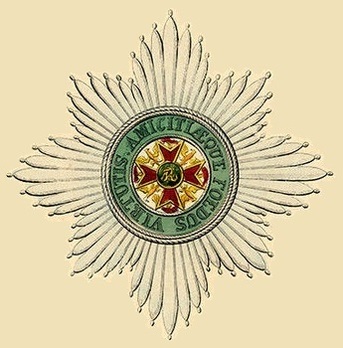Order of the Golden Eagle, Breast Star
CATEGORY: Version
SKU: 01.WUT.0102.103.01.000
Estimated market value:

Estimated market value:
An eight-sided star, constructed of gold and silver wire embroidery. Each ray is made up of several individual rays of varying lengths. The obverse centre medallion is in white or grey silk and features a red cross with golden edges, with stylised golden eagles in between the cross arms and stylised golden hunting horns in between the cross arm tips. The centre is in green and features the crowned golden monogram ‘FR’. The medallion ring is in green and features the golden inscription ‘VIRTUTIS AMICITAEQUE FOEDUS’ (‘covenant of virtue and friendship’), with a rosette at the bottom. Around the ring are silver sequins. The reverse is enforced with paper.
The breast stars vary greatly in size and details. Metal specimens are known to exist, however, these were never official award pieces, but were produced after 1830.
The Order of the Golden Eagle was originally established in 1702 by Duke Eberhard IV of Württemberg as the Order of the Hunt or the Order of St. Hubert. The order was reorganised on March 6, 1807 by Friedrich I and renamed the "Order of the Golden Eagle".
This order was conferred upon royalty, members of the nobility, and senior civil servants who held a rank that was equivalent to at least a Field Marshal Lieutenant. Originally, Knights of the order were required to have noble ancestry that dated back at least 16 generations, but this requirement was removed in November 1812. The decoration was conferred upon royalty, such as sovereign princes, as a means to pay tribute to and demonstrate the friendship between the two parties. Members of the nobility and others received the decoration as a reward for virtue and merit. The order was intended to serve as a public symbol of goodwill and its motto was "Virtutis Amicitiae Que Foedus", which translates to "Virtue and Covenant of Friendship".
The number of Knights admitted to the order was limited to 50, not including members of the king’s family and the members of the reigning prince's family. The children of the king were entitled to receive the order after they were baptised; the king’s first son received the decoration after his first full year of life; the king’s other sons and the uncle of the crown prince received the decoration at the age of 7. The remaining princes of the royal family received the order when they turned 14.
Every recipient of the order was required to conduct himself with dignity and honour, in order to further the reputation of the order. In addition, members of the order were to live in peace with one another, and they were also required to care for and be charitable to the poor.
As master of the order, the king alone decided who was conducted into the order.
On September 23, 1818 the Order of the Golden Eagle was combined with the Order of Civil Merit to create the Order of the Württemberg Crown.
The Cross was suspended from a crimson red ribbon that was worn across the right shoulder and secured above the left hip. The Breast Star was attached to the left breast of the wearer’s tunic. There are embroidered and metal versions of the Breast Star. The metal version was likely privately commissioned, while the embroidered version was an official award piece.
The Cross and Breast Star were awarded 124 times.

Comments
Sign in to comment and reply.


Scroll Top